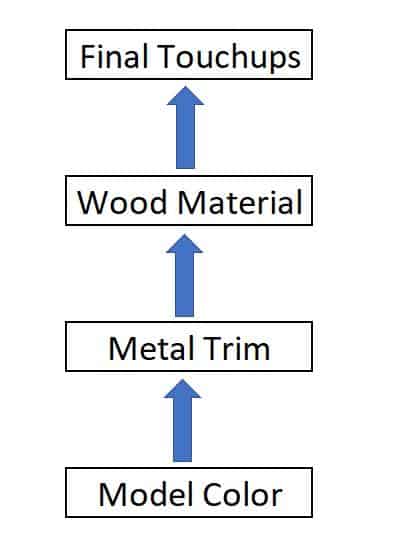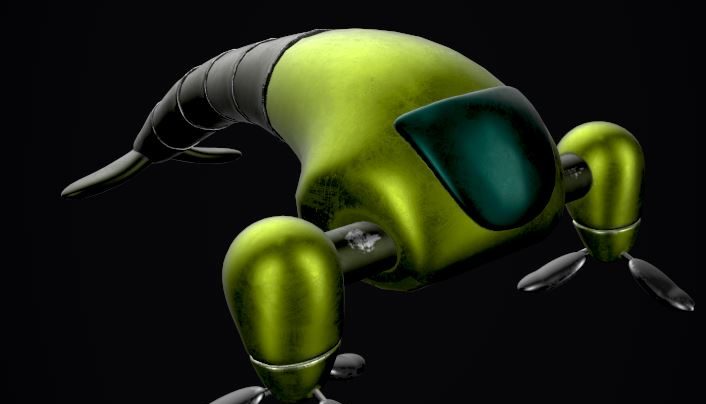Procedural 3d art is a term that gets used quite a lot in the world of 3d however what exactly is it?
Procedural 3d art is a workflow that can be adopted to assist with the creation of 3d art. It uses a stepped-based approach to assist with aspects of 3d to speed up workflows and use parameters to dictate the result rather than manual user input.
In this article, we will discuss exactly what procedural art is, whether you should use it, and how.
How Does Procedural 3d Art Work
How you utilize procedural 3d art differs depending on the program you use but the general principle remains the same. Instead of modeling something or texturing it, you dictate a set of steps to get the same final result.
Illustrated below is a workflow you could use to texture a model. You start with color, then apply a metal texture, a wood texture, a texture to add dirt, and then if you like a final step to do some touch-ups.

All of these steps are separate from each other so for instance if you want to change the color you go to the step where the color is and change it there. If you want to remove the dirt you simply delete the step that adds the dirt. Everything you do is non-destructive if you organize it correctly. This makes it a really powerful tool to use when compared to more traditional methods.
Is Procedural Art Similar to Programming
The general principle is very similar to that of programming you are directing the 3d application on what to do via a set of steps. The biggest difference is you don’t need to write a line of code. Almost everything is drag and drop and very easy to use.
There are varying levels of proceduralism and some programs take it to a whole new level. Houdini is an example of this allowing you to have branching trees or steps as well as coding. A program like this very much does venture into the realm of programming however it gives you a lot more versatility and controls a lot of programs do not. It allows you to take a procedural approach to everything.
Benefits of Procedural 3d Art
There are many benefits that come with taking a procedural approach to 3d art some of the most beneficial includes.
- It is Non-Destructive
- Speeds Up Workflows
- Allows for Quick Iteration
It Is Non-Destructive
With traditional approaches to 3d art you are required to build everything from the ground up as you go. Making any changes can be a time-consuming process. With a procedural approach, this is different.
For example, if you are texturing a model in a program such as Substance Painter or Quixel Mixer.
Traditionally you would paint everything by hand or apply a set of textures to various parts of the model. With procedural texturing, you could layer a set of materials (or what is referred to as Smart Materials in Substance Painter) on top of each other with varying masks until you get the desired result.

If you then decided you wanted to change the color of a certain layer it’s as easy as changing the layer that applies the color without affecting the other layers. There is no long undo chain that will permanently affect your texturing. Everything you do or change is non-destructive.
Speeds Up Workflow
As everything is Non-Destructive changes are very easy to make as there is far less rework.
Further to this using Substance Painter or Quixel Mixer as an example you have procedural materials called Smart Materials. These materials apply texture to a model based on various parameters such as crevices. Instead of hand painting dirt buildups in cavities, the Smart Materials can detect the change in the surface of the model and apply them for you.

This proceduralism can remove hours of meticulous hand painting resulting in minutes of work. Sometimes doing a far better job than you would do yourself.
Allows For Quick Iteration
The non-destructive and quick nature of proceduralism results in very quick iteration. The more design choices you can make by seeing results the better your finished product tends to be.
For example, you do not need to know what color something has to be at the end and hope you are right. You can quickly just keep trying different combinations until you are happy in minutes.
Disadvantages
There are a few disadvantages to procedural art there are but 2 considerable ones.
- Slow to set up
- A little more difficult to learn
Slow to Set Up
There is no doubt that procedural 3d art can save time however there is an amount of initial setup.
Programs like Substance Painter have addressed this by having Smart Materials and doing the hard work for you.
This is not always the case. For example, if you were looking to create your own Smart Materials you can do this in Substance Designer which can be somewhat more time-consuming to set up. The good news is once you have done the setup in theory you can use the resulting material is all future projects.
A Little More Difficult to Learn
Procedural 3d Art has a little more of an element of programming to it than some artists are not familiar with.
It is not as easy as simple sculpting or painting a model and is a different more strategic approach. It can be a bit of a mind shift for some people who are used to more traditional methods.
Is Procedural 3d Art Hard
Depending on what kind of 3d task you are trying to perform will dictate the difficulty. Procedural texturing has been made really easy whereas procedural modeling can get difficult and confusing.
The terminology used in 3d art does not change so there is no requirement to learn anything other than how you create the art.
Will procedural 3d Art Be The New Norm
There is no doubt that procedural 3d art is useful, however it is not likely to be the new norm for all aspects of 3d. It has proven very useful for tasks such as texturing. For other tasks, current procedural methods can be complicated.
While some people will openly welcome such a change a lot of people would prefer more traditional methods.
Its likely that a mixed approach will be the new norm for example procedural for texturing and traditional for modeling.
Procedural vs Traditional 3d Art
Neither procedural nor traditional methods of 3d art are better. Both have very good use cases.
Digital Sculpting is almost impossible to apply a procedural approach. Whereas Procedural Texturing has become more and more popular as time goes on and is almost the new norm. This is not to say it’s the only way taking a manual approach is still very valid.
Program to Utilize Procedural 3d Art
Most programs have applied somewhat of a procedural approach to aspects of their workflow. This includes programs such as Blender and Maya.
There are however some programs that have taken procedural to the next level basing almost their entire workflow on it.
Substance Painter and Quixel Mixer are great examples of this when it comes to texturing.
Houdini has implemented a completely procedural approach to almost all aspects of 3d. It can perform a lot of what Blender or Maya does utilizing a procedural approach. However it does have a little bit of a learning curve even for experienced artists.

Conclusion
There is no doubt procedural art is useful. Its stepped based approach makes it really easy for some aspects such as texturing however not ideal for all apects of 3d. It can be an extremely fun tool to use and I highly encourage you to give it a try if you haven’t already.

